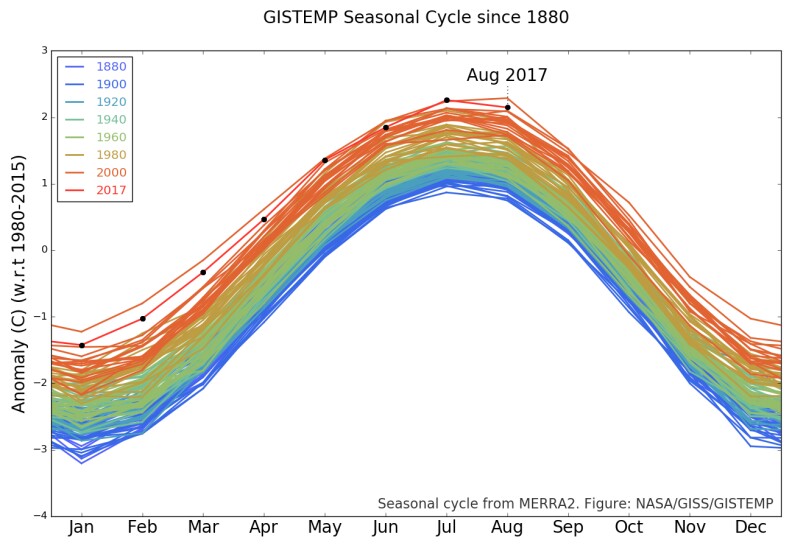With our free press under threat and federal funding for public media gone, your support matters more than ever. Help keep the LAist newsroom strong, become a monthly member or increase your support today.
This archival content was written, edited, and published prior to LAist's acquisition by its current owner, Southern California Public Radio ("SCPR"). Content, such as language choice and subject matter, in archival articles therefore may not align with SCPR's current editorial standards. To learn more about those standards and why we make this distinction, please click here.
August 2017 Was The Second Hottest August Since The Advent Of Modern Record-Keeping

Earth, 1880: the Second Industrial Revolution was well underway; Charles Darwin, Ralph Waldo Emerson, and Fyodor Dostoevsky were all still alive; and the University of Southern California opened its doors to 53 students and 10 faculty members.
1880 is also considered to mark the start of global temperature record-keeping. Although records had certainly been kept before, observations didn't sufficiently cover enough of the planet to provide a global reading, according to NASA’s Goddard Institute for Space Studies. This is why most temperature records refer to the last 137 years, or say something along the lines of "the hottest X in 137 years." It's because that's as far back as our global records go, not because temperatures were just as hot 137 years ago—they weren't. In fact, the average surface temperature has gone up by 0.8 degrees C (1.4 degrees F) worldwide since 1880, according to NASA’s Goddard Institute..
On Monday, NASA announced that August 2017 was the second hottest August the planet had seen since the advent of modern record-keeping. It was surpassed only by August 2016—2016 was also the overall hottest year on record.
The monthly temperature anomalies superimposed on a 1980-2015 mean seasonal cycle. (Image courtesy of NASA)

Click above image to enlarge
According to NASA, that overall rise in temperature since 1880 has been "driven largely by increased carbon dioxide and other human-made emissions into the atmosphere." And most of that warming has occurred over the past 35 years, with 16 of the 17 warmest years on record occurring since 2001.
"Two years ago, we wrote: 'The year 2014 was Earth’s warmest in 134 years of records.' Last year we wrote: '2015 was the warmest year ever recorded on Earth, and it was not even close.' This year, we are running out of ways to say it," the NASA Earth Observatory wrote in January of this year, when they announced the 2016 record.
“We don’t expect record years every year, but the ongoing long-term warming trend is clear,” Goddard Institute Director Gavin Schmidt said in a January statement.
Here in Los Angeles, August 2017 saw the breaking of numerous heat records. And come September, a heat wave in San Francisco turned deadly—and set an overall all-time high-temperature record for the city, likely portending for continued hotter days in SF. Furthermore, rising ocean temperatures will also likely increase the severity of major storms, like those seen in recent weeks.
.@NASAEarth data shows hot water ahead for #HurricaneIrma. Warm oceans are a key ingredient fueling hurricanes: https://t.co/PeoCi4vfZh pic.twitter.com/DGcLY2r0H4
— NASA (@NASA) September 7, 2017
However, when asked about climate change in the immediate wake of Hurricane Irma, Environmental Protection Agency Administrator Scott Pruitt told CNN the question was "insensitive," adding that the time to talk about climate change is "not now." Pruitt, who is in charge of an agency that is literally called the Environmental Protection Agency, haspublicly questioned the link between human activity and global warming.
February, March, April, and May 2017 were all also the second-hottest on record, after 2016. July 2017 tied July 2016 as the hottest on record. NASA's monthly analysis is assembled from publicly available data acquired by about 6,300 meteorological stations around the world, ship-and-buoy-based instruments measuring sea surface temperature, and Antarctic research stations, according to their website.
At LAist, we believe in journalism without censorship and the right of a free press to speak truth to those in power. Our hard-hitting watchdog reporting on local government, climate, and the ongoing housing and homelessness crisis is trustworthy, independent and freely accessible to everyone thanks to the support of readers like you.
But the game has changed: Congress voted to eliminate funding for public media across the country. Here at LAist that means a loss of $1.7 million in our budget every year. We want to assure you that despite growing threats to free press and free speech, LAist will remain a voice you know and trust. Speaking frankly, the amount of reader support we receive will help determine how strong of a newsroom we are going forward to cover the important news in our community.
We’re asking you to stand up for independent reporting that will not be silenced. With more individuals like you supporting this public service, we can continue to provide essential coverage for Southern Californians that you can’t find anywhere else. Become a monthly member today to help sustain this mission.
Thank you for your generous support and belief in the value of independent news.

-
What do stairs have to do with California’s housing crisis? More than you might think, says this Culver City councilmember.
-
Yes, it's controversial, but let me explain.
-
Doctors say administrator directives allow immigration agents to interfere in medical decisions and compromise medical care.
-
The Palisades Fire erupted on Jan. 7 and went on to kill 12 people and destroy more than 6,800 homes and buildings.
-
People moving to Los Angeles are regularly baffled by the region’s refrigerator-less apartments. They’ll soon be a thing of the past.
-
Experts say students shouldn't readily forgo federal aid. But a California-only program may be a good alternative in some cases.







